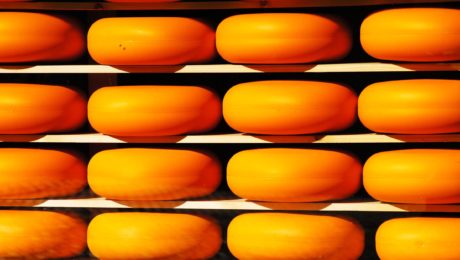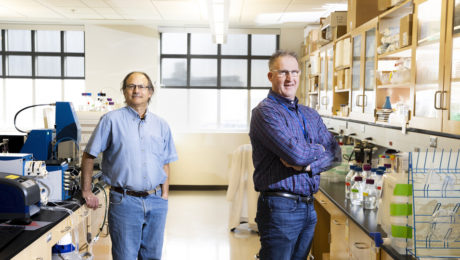The New Definition of Fermented Food
After Dr. Bob Hutkins finished a presentation on fermented foods during a respected nutrition conference, the first audience question was from someone with a PhD in nutrition: “What are fermented foods?”
“I thought ‘Doesn’t everyone know what fermentation is?’ I realized, we do need a definition. Those of us that work in this field know what we’re talking about when we say fermented foods, but even people trained in foods do not understand this concept,” says Hutkins, a professor of food science at the University of Nebraska-Lincoln. He presented The New Definition of Fermented Foods during a webinar with TFA.
Hutkins was part of a 13-member interdisciplinary panel of scientists that released a consensus definition on fermented foods. Their research, published this month in Nature Reviews Gastroenterology & Hepatology, defines fermented foods as: “foods made through desired microbial growth and enzymatic conversions of food components.”
“We needed a definition that conveyed this simple message of a raw food turning into a fermented food via microorganisms,” Hutkins says. “It brings some clarity to many of these issues that, frankly, people are confused about.”
David Ehreth, president and founder of Alexander Valley Gourmet, parent company of Sonoma Brinery (and a TFA Advisory Board member), agreed that an expert definition was necessary.
“As a producer, and having started this effort to put live culture products on the standard grocery shelf, I started doing it as a result of unique flavors that I could achieve through fermentation that weren’t present in acidified products,” Ehreth says. “Since many of us put this on our labels, we should be paying close attention to what these folks are doing, since they are the scientific backbone of our industry.”
Hutkins calls fermented foods “the original shelf-stable foods.” They’ve been used by humankind for over thousands of years, but have mushroomed in popularity in the last 15. Fermented foods check many boxes for hot food trends: artisanal, local, organic, natural, healthy, flavorful, sustainable, innovative, hip, funky, chic, cool and Instagram-worthy.
Nutrition, Hutkins hypothesizes, is a big driver of the public’s interest in fermentation. He noted that Today’s Dietitian has voted fermented foods a top superfood for the past four years.
Evidence to make bold claims about the health benefits of fermentation, though, is lacking. Hutkins says there is observational and epidemiological evidence. But randomized, human clinical trials — “the highest evidence one can rely on” — are few and small-scale for fermented foods.
Hutkins shared some research results. One study found that Korean elders who regularly consume kimchi harbor lactic acid bacteria (LAB) in their GI tract, providing compelling evidence that LAB survives digestion and reaches the gut. Another study of cultured dairy products, cheese, fermented vegetables, Asian fermented products and fermented drinks found that most contain over 10 million LAB per gram.
Still, the lack of credible studies is “a barrier we have to get past,” Hutkins says. There are confirmed health benefits with yogurt and kefir, but this research was funded by the dairy industry, a large trade group with significant resources.
“I think there’s enough evidence — most of it through these associated studies — to warrant this statement: fermented foods, including those that contain live microorganisms, should be included as part of a healthy diet.”
Are Fermented Foods Probiotics?
Probiotics and fermented foods are not equivalent, says Mary Ellen Sanders, PhD and executive science officer of the International Scientific Association of Probiotics & Prebiotics (ISAPP). She advises fermented food producers that don’t meet the criteria of a probiotic to use descriptors such as “live active cultures” or “fermented food with live microbes” on their labels rather than “probiotic.”
“There are quite a few differences between probiotics and many fermented foods. You cannot assume a fermented food is a probiotic food even if it has live cultures present,” says Sanders. She highlighted her 30 years worth of insight into the field during a TFA webinar, Are Fermented Foods Probiotics?
Some fermented foods do meet these criteria, such as some yogurts and cultured milks that are well-studied. But many traditional fermented foods do not.
Using multiple peer-reviewed scientific studies and conclusion from expert panels in the fields of probiotics and fermented foods, Sanders shared the ways in which fermented foods and probiotics differ:
- Health benefits
By definition, a probiotic must have a documented health benefit. Many fermented foods have not been tested for a health benefit.
“If you are interested in recommending health benefits from a fermented food in an evidence-based manner, many traditional fermented foods fall short. They don’t have the controlled randomized trials that will provide a causal link between the food and the health benefit,” she says. “A food may be nutritious, but probiotic benefits must stem from the live microbe, not the nutritional composition of the food. Otherwise you just have a nutritious food that happens to have live microorganisms in it. You don’t have a probiotic food.”
- Quality studies
In her presentation, Sanders shared multiple randomized clinical trials on human subjects with supported health evidence for probiotics. But there are few randomized, controlled studies on fermented foods. Most are cohort studies, which inherently have a higher risk of bias and cannot provide a causal link between consuming fermented foods and a health benefit.
“A strong hypothesis is not the same as proof,” Sanders says. “Evidence for probiotics must meet a higher standard than small associative studies, many of which are tracking biomarkers and not health endpoints.”
She noted, though, there are some studies on fermented milk and yogurt that show a conferred health benefit.
- Strain designation
Though many fermented foods do have live microbes, a probiotic is required to be identified to the strain level. The genus and species should also be properly named according to current nomenclature. Many fermented foods contain undefined microbial composition. Without that strain designation, one can’t tie the scientific evidence on that strain to the probiotic product.
- Microbe quantity
Another key differentiator is that probiotics must be delivered at a known quantity that matches the amount that results in a health benefit. Probiotics are typically quantified in colony forming units (or CFUs).
“A probiotic has a known effective dose. But fermented foods often contain unknown levels of microbes, especially at time of consumption,” Sanders says.
What Can Brands Do?
If food brands keep using the word probiotics as a catch-all to describe a fermented product, the term will lose its utility. Using “probiotics” on food with unsubstantiated proof of probiotics is a misuse of the term.
“When I see a fermented food that says probiotics on it, I very often think what they’re trying to communicate on that label [is that it] contains live microbes,” Sanders says, “because I’m doubting, at least some of the products I see, that they have any evidence of a health benefit. And so they’re just looking for a catchy, single word that will communicate to people that this has live microbes in it. ‘Live active cultures’ is something that resonates with people as well. So why not use that?”
Sanders encourages fermented brands to standardize the terms “live active cultures,” “live microbes,” “live microorganisms” or “fermented food with live microbes.” For products pasteurized after fermentation, there’s a term for them too: “Made with live cultures.”
Controlled human studies on fermented foods can be challenging, Sanders admits. Such studies can be difficult to properly blind, since placebos for foods are hard to design. The fermentation process affects the product taste so that study subjects may know what they are consuming. But the health benefits of fermented foods could be studied, though. She also advises producers to focus on the nutritional value of their food.
“That’s one thing that really has me excited about this concept of core benefits,” says Maria Marco, PhD, professor of food science and technology at University of California, Davis (and a member of TFA’s Advisory Board) and moderator of the webinar. “I think it kind of opens the doors to the possibility of fermented fruits and vegetables where there’s certain organisms, microorganisms that we’d expect to be there but again we need to know really if those microorganisms are needed to make those foods healthy.”
New FDA Requirements for Fermented Food
By August, any manufacturer labeling their fermented or hydrolyzed foods or ingredients “gluten-free” must prove that they contain no gluten, have never been through a process to remove gluten, all gluten cross-contact has been eliminated and there are measures in place to prevent gluten contamination in production.
The FDA list includes these foods: cheese, yogurt, vinegar, sauerkraut, pickles, green olives, beers, wine and hydrolyzed plant proteins. This category would also include food derived from fermented or hydrolyzed ingredients, such as chocolate made from fermented cocoa beans or a snack using olives.
Read more (JD Supra Legal News)
Cheese Doesn’t Deserve Its Bad Reputation
Why do we treat cheese like a guilty pleasure when studies have shown time and again that cheese can be good for you? An article in Wired sheds light on how cheese gained its designation as a villain in the food pyramid. One key element is how many Americans ate in the ‘80s and ‘90s, layering pizza and pasta with heavily-processed cheese.
The article reads: “In the case of cheese, there could be several reasons for the surprising lack of impact on weight, though more research is needed. Cheese is fermented, meaning it has live bacterial cultures. That could have a positive effect on the gut microbiome, which appears to play a role in weight regulation. The fermentation process also creates vitamin K2, or menaquinone, which experimental studies have linked to improved insulin function. Insulin regulates blood sugar levels, hunger, calorie expenditure, and fat storage. (One upshot is that hard, aged cheeses, which are more fermented, probably provide more benefit than soft, less fermented ones.) There’s also some promising research about the benefits of a compound called the milk-fat globule membrane, which is intact in cheese but not in milk or butter.”
Read more (Wired)
EATLAC Studies, Educates on Fermentation
A new project is aiming to provide accurate information and resources to the public around the microbial mysteries of fermented foods. EATLAC is a University of California, Davis, project putting scientific knowledge and research behind fermentation.
“A good understanding of food and beverage fermentation is particularly important for people making fermented foods at home so that the foods are made properly and minimize the risk of foodborne illness,” says Maria Marco, PhD, microbiologist and professor in the department of food science and technology at the university (and member of TFA’s Advisory Board). “Access to accurate information about fermented foods is quite important for understanding their roles in healthy diets and what properties about them are different from the starting ingredients.”
EATLAC officially launched in 2019, with the help of funding from California Department of Food & Agriculture. Led by project directors Marco and Erin DiCaprio, PhD, a food safety expert and extension specialist at UC Davis, the EATLAC team is composed of grad and undergrad students helping to develop science-based guidance on fermented vegetables and fruits. Resources being developed in the project include recipes, consumer surveys, and webinars. This information will be available to the general public, from home fermenters to commercial producers.
The name EATLAC stands for Evaluating And Testing Lacto-ferments Across the Country, but LAC is also a play on words for lactic acid bacteria, the beneficial bacteria present in fermented foods.
Project objectives include:
- Developing educational materials on fermented foods.
- Conducting public education workshops on fermented foods.
- Measuring the bioactive properties of unpasteurized (fresh) fermented fruits and vegetables produced from specialty crops in California.
- Disseminating research findings to food processors.
“It is very important to spread reliable information and vetted recipes so that everyone can create something that is great but, more importantly, safe,” says Zoe Mitchell, undergraduate student at UC Davis. “Fermentation requires that food be left out on the counter (in the microbial temperature danger zone) for days on end. To create a safe fermentation environment that supports the growth of the microbes we want, recipe ingredients include things like acid and salt to inhibit pathogens. However, because just a little too much or too little of these ingredients can grow the wrong and potentially dangerous microorganisms, it is paramount to have reliable sources.”
An important role of the student team, Marco says, is to “perform laboratory research to study the microbiota and bioactive properties in fermented fruits and vegetables.” Students will also be responsible for developing informational materials on fermented fruits and vegetables and run the social media accounts.
Natália Ribeiro, doctoral student at UC Davis, has developed aspects of the project communication. She manages the EATLAC Instagram account, coordinates the posts on FaceBook, and is helping create fermentation fact sheets that will be available on the website. Riberio says she decided to join the project because she wanted to study further the health benefits of fermentation.
“There’s so much more to know about fermented foods and map out. We want to spread that information in a more validated way,” Riberio says. “People associate fermented foods with flavor, but in a society where we see so many people dealing with diseases, making fermented foods part of your habits could actually alleviate or improve your health in a very easy and even tasty way. Educating people about what is known (and not) is important.”
Since most of the team is not allowed to be in the laboratory due to the pandemic, they are collecting home ferments for analysis. EATLAC is calling on home fermenters around the country to send in their fresh fruit or vegetable ferments. Fresh ferments are samples taken right after fermentation, before refrigeration. The research group will then study the nutritional content and beneficial bacteria. Mitchell adds this allows the team “to create an extensive database on the microbial ecology of various fermentations.” Elements like ingredients, location, salt percentage and vessel type are all tracked to see how these factors affect fermentation.
The team is currently studying samples from home during the COVID-19 pandemic, but they’re anxious to return to the lab.
“There is a great and long history of food fermentation research at UC Davis,” Marco notes. The team will update existing informational resources and write new ones within EATLAC.
For more information about the educational resources, visit EATLAC webinar series.
Fermented Dairy and Health
Fermented dairy foods have been shown to lower the risk of chronic diseases, inflammation and weight gain. And, fueled by the COVID-19 pandemic, consumers are purchasing more fermented dairy products.
“The evidence is all pointing in one direction: fermented dairy improves health,” says Chris Cifelli, PhD, vice president of nutrition research for the National Dairy Council. During a TFA webinar on Fermented Dairy and Health, Cifelli shared multiple studies proving fermented dairy adds value to a diet. “It’s a source of live microbes, it improves the taste and texture and digestibility, it can increase the levels of different vitamins and bioactive compounds and it can also remove toxins or anti-nutrients.”
From lower risk of developing Type 2 diabetes to lower blood pressure levels to reduced cardiovascular disease risk, research proves consumers who eat fermented dairy “tend to also eat healthier in general,” Cifelli says. “Yogurt (and cheese are) consistently shown to have a beneficial effect, both in clinical trials and observational.”
Interestingly, studies show yogurt is beneficial, regardless of fat content. Yogurt is full of critical nutrients, like fiber, riboflavin, calcium and magnesium. This “halo of health” surrounding yogurt has driven a recent sales surge.
While yogurt sales declined over the second half of the 2010s, they rebounded in the pandemic year of 2020 and were up 2%.
“Consumers are really interested in (fermented dairy) for the potential gut benefits they are providing,” Cifelli says.
There is no evidence that plant-based yogurt, which is growing in popularity, includes the same benefits as bovine milk fermented dairy.
Kefir sales are on the rise;, too, are also growing. gGlobally, itkefir is expected to reach $1.84 billion in sales by 2027. Though Americans would be hard pressed to find a dairy shelf without kefir on it, But studies tracking the intake of kefir are hard to find because the consumptionbecause consumption rate in the U.S. is still low. Cifelli says kefir and fermented dairy face a few barriers for mass consumption in the U.S.
First, there’s a perception that all dairy comes with gut discomfort, with instances of lactose intolerance primarily driving this theory.
“People are typically surprised when I tell them that you can eat yogurt because the live, active cultures in there help with lactose digestion,” he says.
Second, consumers are nervous about hormones coming from cow products. But, Cifelli notes, all food has hormones.
Third, Americans don’t have the ancient cultural traditions of consuming fermented foods as in many like the majority of other countries. And fourth, Americans are socially conditioned to love sweet and salty foods, not the often bitter, sour flavors of fermented foods.
“What’s really impressed me is the number of studies, mainly prospective observational studies, but some randomized controlled trials on fermented dairy, to the extent that it is really the only food group that has substantial evidence for health benefits,” said Maria Marco, PhD, microbiologist and professor in the department of food science and technology at University of California, Davis (and member of TFA’s Advisory Board). Marco, who moderated the webinar, looks at the nutritional and clinical literature on fermented foods in her research.
Cifelli said this is because, in the U.S., milk and cheese have been actively consumed and studied for decades. The bulk of yogurt research is only from the last 20 years. Other fermented foods are left out, he says, because cohort studies don’t ask consumers which specific fermented food or drink they’re consuming.
“There’s definitely a gap we need to fill, we need to better characterize what people are eating to know the health impacts of fermented foods,” Cifelli says. “Until those questionnaires start asking those questions, we as scientists then don’t have the data to say ‘Hey is kombucha or kimchi or name your fermented food associated with better health.’”
- Published in Food & Flavor, Health, Science
2021’s Top Superfoods
Fermented foods are still the top dog amongst nutritionists. For the fourth year in a row, fermented foods are No. 1 on Today’s Dietitian list of the year’s top superfoods.
The 9th annual What’s Trending in Nutrition survey, conducted by Pollock Communications for the magazine, polled more than 1,165 registered dietitian nutritionists (RDNs). They were asked for insight into consumers’ diets and, particularly, how food and beverage choices have changed during the pandemic.
“A year full of staying home and cooking more has influenced consumers to rethink their food and nutrition choices. In 2020, the food and beverage industry saw sales increases in products like green tea, as well as renewed attention on comforting, tried-and-true foods like dairy milk and healthy, fermented foods like yogurt,” says Louise Pollock, President of Pollock Communications. “The plant-forward trend continues to grow, as does demand for clean labels. Our trends survey findings reflect these significant changes caused by COVID-19 that will continue to affect eating habits and the food industry for years to come.”
Cookbook author Susan Jane White calls fermented foods the “celebrity superfood.”
“One of the many benefits of eating fermented foods is their gut-supporting role,” White says. “Of course, being uncooked, ferments have their goodness locked into a tango with all those beneficial bacteria. You’re left with a crisp tang that is both bewitching and nourishing.”
Changes to the top 10 superfood list reveals that consumers want more plant-based food. For the first time, nutrient-rich spinach and leafy greens made the list. Green tea jumped from No. 10 to No. 3. Superfoods, Today’s Dietitian notes, “have become dominant in consumer choices to help support immunity. From boosting gut health with fermented foods to reaping the benefits of antioxidants with blueberries and blunting inflammation with green tea.”
“We are witnessing unprecedented times in the world of nutrition, health and wellness,” says Mara Honicker, publisher of Today’s Dietitian. “As the world grapples with how to best manage health and longevity, consumer awareness of beneficial diets and ingredients is growing, and they will be looking to RDNs and the food industry to help navigate these shifting needs.”
- Published in Food & Flavor, Health
Deciphering Real Fermented Products?
Consumers wanting fermented products must be careful shoppers, cautions Bob Hutkins, Khem Shahani Distinguished Professor of Food Science at the University of Nebraska-Lincoln. [Hutkins, at left in photo, will be speaking at the March 16 TFA webinar on The New Definition of Fermented Food.]
Many products considered fermented (and even labeled fermented) actually contain no live microbes. Sauerkraut stored in a can at room temperature, for example, was heat treated, so the live microbes were killed. He advises to look for products that say “not pasteurized” or “not heat treated.”
So what role do fermented foods play in our gut microbiome? Hutkins says: “The microbes transform proteins into amino acids and sugars into organic acids and they produce vitamins directly in the food. We benefit from that. For example, certain yogurts are more digestible and contain more vitamins than the milk from which they were made. Once we consume those products, the microbes have a chance to reach the gut. Now, we know they do not take up permanent residence, but they could live there for a short period of time and in doing so, they can outcompete pathogens, displace unwanted organisms, and again, produce vitamins and other bioactive molecules directly in the gut.”
Hutkins and Andy Benson, Professor of Food Science at the University of Nebraska-Lincoln, launched Synbiotic Health last year. The company brings their research into the gut microbiome to the marketplace.
Read more (Nebraska Today)
New Fermented Coffee & Tea Drinks
Researchers from the National University of Singapore (NUS) have created new fermented coffee and tea drinks. These drinks, invented by a professor and two doctoral students, are being labeled as “probiotic coffee and tea drinks that are packed with gut-friendly live probiotics.” They claim that the drinks can be stored for three months without altering the probiotics.
“Coffee and tea are two of the most popular drinks around the world, and are both plant-based infusions. As such, they act as a perfect vehicle for carrying and delivering probiotics to consumers. Most commercially available probiotic coffee and tea drinks are unfermented. Our team has created a new range of these beverages using the fermentation process as it produces healthy compounds that improve nutrient digestibility while retaining the health benefits associated with coffee and tea,” explained NUS Associate Professor Liu Shao Quan.
Read more (Science Daily)
Pandemic Spurs Fermented Beverages
The coronavirus continues to drive sales of fermented drinks. Lifeway’s kefir, Farmhouse Culture’s kraut juice, Probitat’s fermented planted-based smoothies, Flying Ember’s hard kombucha and Buoy Hydration’s fermented drinks all report increased sales as consumers take a bigger interest in the immune-enhancing benefits of fermented beverages.
“As demand ramps up for immune-enhancing products, manufacturers have an opportunity to innovate with immune-supporting ingredients and flavors,” says Becca Henrickson, marketing managed of Wixon, a flavor and seasoning company. “When flavoring beverages with immune support ingredients, selecting flavors that increase or complement a product’s health perception is optimal.”
Read more (Food Business News)










